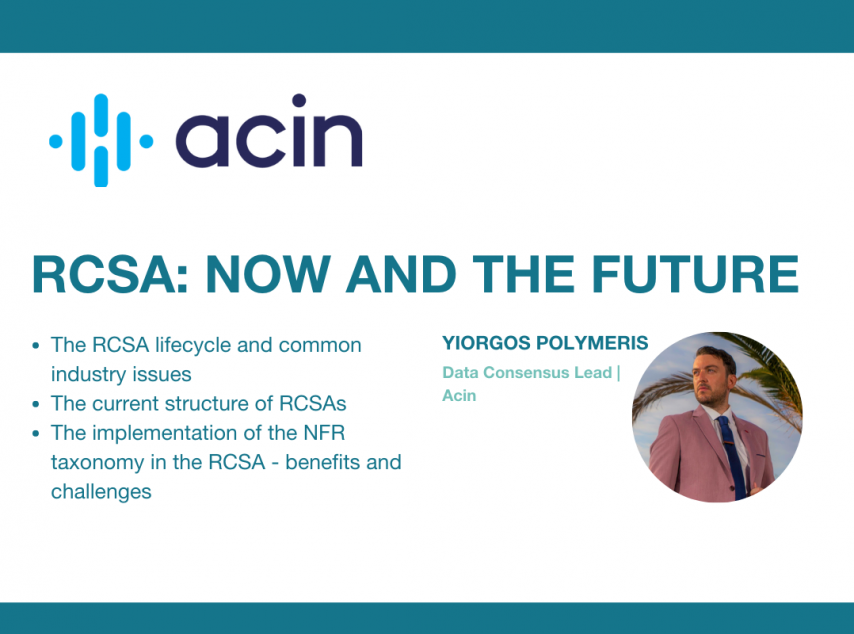
Event
Webinar: RCSA – Now and the future with Yiorgos Polymeris
Non-Financial Risk (NFR) poses a formidable threat to the reputation, financials and operational resilience of regulated financial institutions. The time has come to embrace technology and begin collaborating – enterprise and industry wide – to tackle this issue collectively.
The upcoming Spring 21 release of the Acin Platform has a host of new capabilities and features, and is already described by current customers as “revolutionary”. Why so?
The historical practice of managing risk data in silos, working from spreadsheets, and paying high-cost consultancies to do the legwork around Non-Financial Risk Management (NFRM) is an inefficient, ineffective, incomplete and inappropriate way to manage NFR. With ever-rising stakes, a technology-enabled step change is required.
Until 2018, neither the technology nor the infrastructure existed to quantify and calibrate NFR in the same way that market and credit risk have been for several decades. That began to change when the Acin Platform and Acin Network were borne.
Acin’s upcoming Spring 21 release could not be timelier. In an April 2021 Consultation Paper the Financial Conduct Authority (FCA) revealed that they are themselves using peer analysis to identify outliers. Furthermore, they indicated that regulated financial institutions “may use peer analysis to estimate potential harms. When doing so, the firm should take into account any material differences between the firm’s business and the business carried on by its peer, and to the extent that it is aware of them, any material differences in their respective systems and controls.”
In reality, how many financial institutions have these capabilities today?
The Spring 21 release promises to have a game-changing impact on the future of NFRM, enabling you to rationalize RCSA processes, assess risk tolerance and appetite objectively – versus peers – and reduce costs.
With the Acin Platform you can access all NFR data via one login, to one unified platform, and get everyone talking the same language. Our intelligent data protocols convert your firms’ data to a standard language. Using Natural Language Processing (NLP) and Machine Learning (ML) Acin maps your data onto the consensus data of the Acin Network. Every user with appropriate permissions can see at a glance your firm’s risk and controls status versus the Acin Network.
Your risk and control environment is viewed on an intuitive graphical dashboard, providing complete oversight of your front to back risk and control inventories, by business, function or enterprise-wise. This is essential to improve management oversight, especially for firms like J.P. Morgan, who are looking to operate more cohesively front to back across the three lines of defence.
With the Spring 21 release – for the first time ever – it will be possible to quantify NFR. By identifying and quantifying your risks and controls – and creating your firm’s individual ‘Acin Score’ – you can automatically compare and track your risk and control design over time. You can evaluate your score versus industry consensus, and calibrate against peers. Subjective, anecdotal conversations with both internal and external stakeholders will become a thing of the past, due to the availability of quantifiable, fact-based data upon which decisions can be made.
The Spring 21 release adds a powerful new risk lens to the calibration capability of the Acin Platform, in addition to the control lens provided previously. The combination of risk and control calibration delivers more robust support for your RCSA processes, enables you to identify the disparity between your risk appetite and that of your peers, and equips you to make more robust decisions relating to control design.
Scenario analysis is a powerful means of assessing the likely impact of emerging risks. The Acin Platform automatically alerts you to newly emerging risks, using advanced analytics and insights driven by interactive risk intelligence, horizon scanning and Acin network data. Regulatory alerts relating to updates, enforcement actions and fines are also available through the Acin Platform.
Spreadsheets have proven to be an inept way to monitor risk and control environments, accurately and transparently over time. With Acin’s Spring 21 release, your team is empowered to be more proactive, build operational resilience and continuously improve, by comparing regulatory, risk and control data collectively, shoulder to shoulder with industry peers.
Returning to the question posed earlier in this blog: “In reality, how many financial institutions have these capabilities today?”
Answer: All Acin Network members who, within the past two years, recognized the need to adopt a pioneering approach to NFRM, and are already on the front foot with the Regulator.